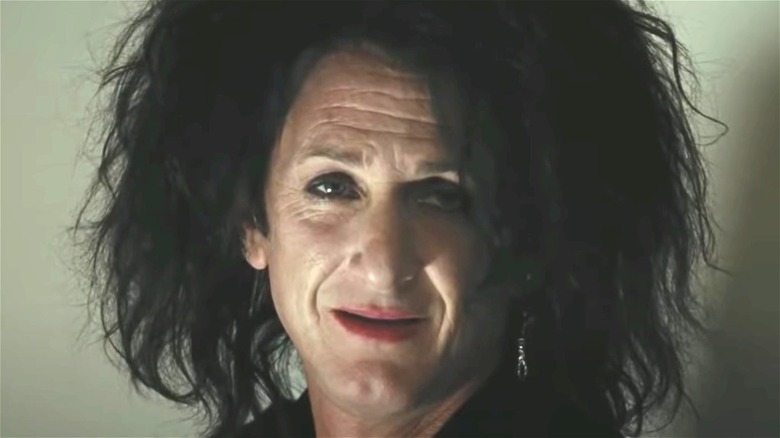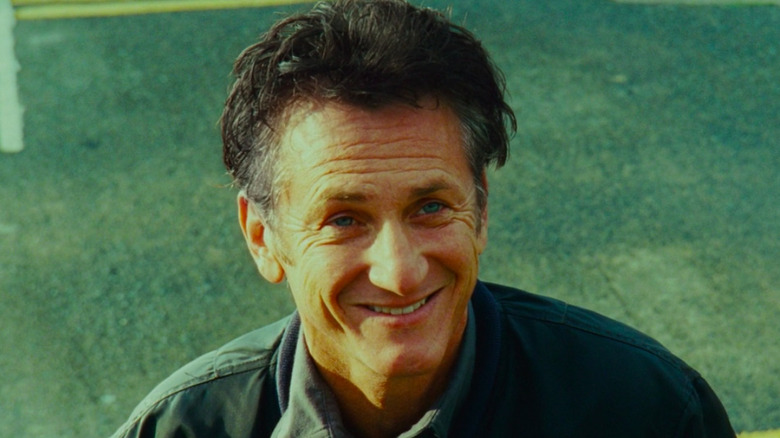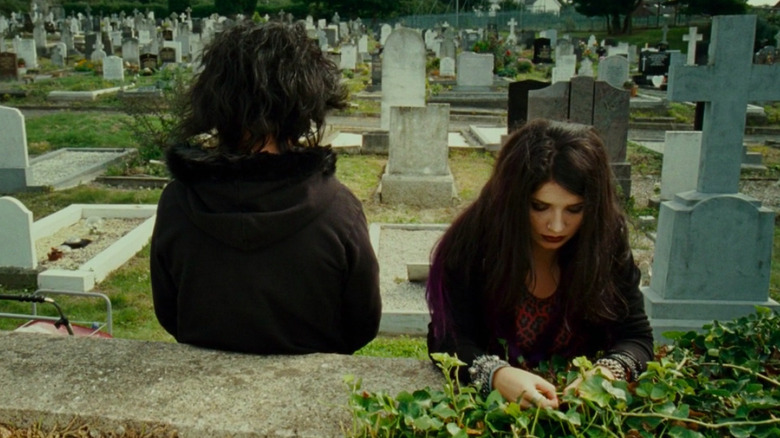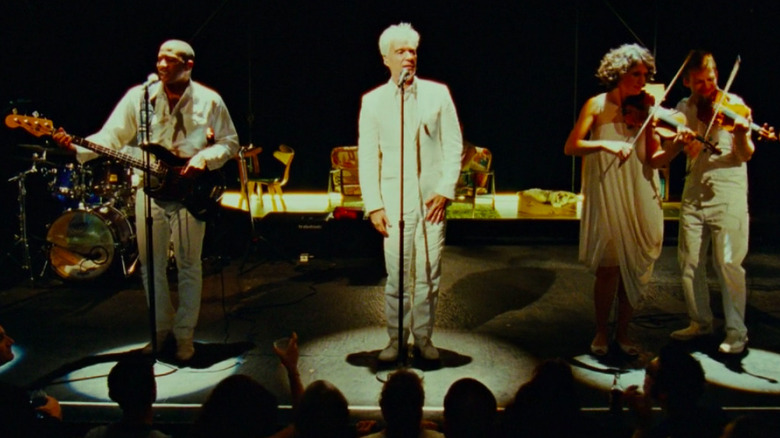The Ending Of This Must Be The Place Explained
In a nearly unrecognizable performance in "This Must Be the Place," Sean Penn transforms into Cheyenne, a washed-up goth pop star grieving the death of his estranged father, a Holocaust survivor. While grappling with the 30 years they hadn't spoken, the reclusive musician resumes his father's obsessive hunt for the SS officer who humiliated him at Auschwitz.
The 2011 film directed by Paolo Sorrentino explores grief, generational trauma, and growing up. By the end of the film, Cheyenne tracks down the infamous now-blind Alois Lange (Heinz Lieven) with the help of Nazi hunter Mordecai Midler (Judd Hirsch). Rather than killing the man "with impunity," he makes him strip down, like the prisoners at Auschwitz were, and strands him in the barren Utah salt plains. With his father's lifelong mission complete, Cheyenne returns home and sheds his Edward Scissorhands hairstyle, heavy makeup, and all-black attire.
No longer rocking his decades-old style, he gazes up at a friend, and the two smile tearfully at one another as the film's title track softly plays in the background.
So, what does that wordless exchange mean? Why did Cheyenne cut off his hair? Why is the film named after a new wave love song from the 1980s? Here's everything you need to know about the ending of "This Must Be the Place," explained.
Revenge is a dish best served cold
"Your father was too much alone," Midler told Cheyenne. "He started feeding his resentment towards someone who was a lot less wicked than many others." Of course, Midler wasn't trying to minimize the survivor's pain or diminish Lange's role as a Nazi war criminal. He was trying to give Cheyenne perspective on how pedantic it was to search for someone like Lange, a "small fish" compared to the other "sharks" he usually hunted for.
When Cheyenne confronts Lange, it's revealed that his late father had been sending threatening letters for years over an incident that made him wet himself at the concentration camp. "Compared to the horrors of Auschwitz, it was nothing," said Lange. "But your father never forgot it."
This concept of grudges and resentment comes up throughout the film, and Cheyenne's decision to move forward implies that he's breaking the cycle his father was trapped in. For the former musician, his trauma came when two fans committed suicide and their families blamed his music. He is as stuck as his father was on something he had no control over. His transformation at the end of the film signifies a change within him, that maybe he's ready to work through the pain of what happened.
Growing up and moving on
While Cheyenne's appearance isn't necessarily holding him back, it represents his inability to grow and his stubbornness to let go of the style his father disproved of. Sorrentino was inspired by The Cure's frontman Robert Smith who never changed his gothic style. The director described Smith to IFTN as "a fifty-year-old who still completely identified with a look which, by definition, is that of an adolescent."
Similarly, the stunted man hangs out with Mary (Eve Hewson), a young fan-turned-friend, and her mother (Olwen Fouéré), who is struggling to cope with the disappearance of her son, Tony. When Cheyenne is away searching for Lange and aloof about his return date, the jaded teenager assumes he is leaving them as well.
Toward the beginning, Mary's mother points out that Cheyenne doesn't smoke cigarettes because he "remained a child." Before he goes to see her, he tries smoking for the first time, signaling his willingness to move into adulthood. Cheyenne's surprise return stuns Mary's mother, who spends her days waiting by the phone and peering out the window for her son.
The emotional look they share implies that this change was something they both needed. For Cheyenne, it's about growing up, and for the troubled mother, it's a hopefulness that Tony could come back to her too.
This Must Be the Place by Talking Heads, not Arcade Fire
"Trust me, you're delusional," Cheyenne tells Tommy, a cherub-faced young boy who asks him to play Arcade Fire's cover of "This Must Be the Place" so he can sing along to it. Ironically, the film's soundtrack includes five covers of the song.
While the Talking Heads track is a love song, the film emphasizes its themes about home and the passage of time. Sorrentino said that he chose the film's music "from the heart," wanting to capture the "incredible emotion and passion" of discovering rock music for the first time (via IFTN). The director was surprised that Talking Heads frontman David Byrne not only agreed to let him use the song's title but agreed to compose its soundtrack and cameo in the film.
Following a club performance of "This Must Be the Place," Cheyenne breaks down while talking to Byrne about the premature end of his career. "And I just wrote dreary songs because they were all the rage and made tons of money, just depressed songs for depressed kids, and two of them, more fragile than the rest, ended up doing themselves in as a result of it," he cries.
Throughout the film, Cheyenne notes that "Something is not quite right here." By the end, though, he begins to embody the "It's OK, I know nothing's wrong" line from the song because he's finally making peace with letting go and being home.



